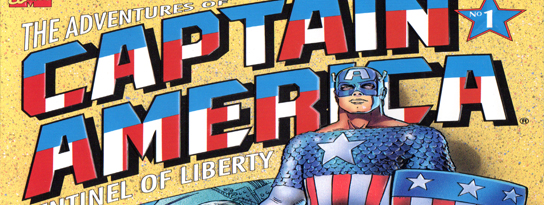
The Adventures of Captain America: Sentinel of Liberty
Storytellers: Fabian Nicieza and Kevin Maguire
Pencillers (Issue 4): Steve Carr and Kevin West
Inks: (Issue 1) Joe Rubinstein (Issues 3-4) Terry Austin
Letters: Richard Starkings
Colors: Paul Mounts
Published by: Marvel Comics
Reviewed by: Kristian Horn
Several decades ago, Marvel wasn’t the powerhouse movie studio it is today. There was a time when no one cared to put Marvel’s, or anybody’s, superheroes into movies. There was also a time when Captain America wasn’t necessarily seen as the hippest hero on the block. Not that he is now, but I don’t think I’d be stretching things if I said I thought that the Marvel movies hadn’t given the public at large a somewhat renewed appreciation for the character. As a long time fan of the character, it does my heart good to see Cap getting to be the lynchpin that much of the Marvel cinematic universe is hanging its hat on.
But there was a time, again, when this was not the case. In 1990 a Captain America movie did go into production and was actually set to be released in theaters. Unfortunately, the movie was such a turd that it never saw the darkness of a movie theater and was so bad that it barely got a home video release. If you want to get an idea of how badly the Captain America property can spin out of control just check the movie out. It will really help you appreciate how solid the last two Captain America movies have been.
 Even though the Albert Pyun helmed Captain America flick turned out to be a real Turkey, that didn’t stop Marvel from actively pushing the character’s profile for his 5oth anniversary in 1991…most notably with this prestige format limited series…The Adventures of Captain America: Sentinel of Liberty. Cap had certainly been a lynchpin of the Marvel Universe for a long time but, as far as I’m aware, he had yet to get the singular graphic novel treatment. It’s important for readers to note that while these prestige format books were becoming a bit more prevalent at the time, they were still seen as somewhat more of a bigger deal than the average newsprint monthlies. They had a higher price point and they also had better paper and cover stock; so when one of these books came out it signaled that the publisher had a special tale to tell and that comic fans should sit up and take notice.
Even though the Albert Pyun helmed Captain America flick turned out to be a real Turkey, that didn’t stop Marvel from actively pushing the character’s profile for his 5oth anniversary in 1991…most notably with this prestige format limited series…The Adventures of Captain America: Sentinel of Liberty. Cap had certainly been a lynchpin of the Marvel Universe for a long time but, as far as I’m aware, he had yet to get the singular graphic novel treatment. It’s important for readers to note that while these prestige format books were becoming a bit more prevalent at the time, they were still seen as somewhat more of a bigger deal than the average newsprint monthlies. They had a higher price point and they also had better paper and cover stock; so when one of these books came out it signaled that the publisher had a special tale to tell and that comic fans should sit up and take notice.
The other thing that signaled that this was a Captain America book that “mattered” was the fact that Marvel had gone out of their way to pilfer one of their Direct Competition’s bigger talents. Kevin Maguire was most famously known for helping to revitalize the Justice League at DC Comics after their universe shattering Crisis on Infinite Earths event. Along with Keith Giffen and J.M. DeMatteis, Maguire breathed new life into a title that had been staid and boring for the longest time. As a matter of fact, the Giffen, DeMatteis, and Maguire run of the Justice League is still one that is fondly remembered by comic fans to this day. The title was so popular at the time of its release that Maguire’s art almost became synonymous with the DC Comics itself for a while…which is why bringing Maguire over to Marvel for a prestige format Captain America series was seen a as really big coup for Marvel. During this time, it wasn’t like artists were particularly jumping back and forth between the big two all of the time. Sure, DC had co-opted many of Marvel’s top talents during the eighties with such luminaries as John Byrne or Frank Miller…but for the most part if you were a big artist at Marvel or DC you stayed at Marvel or DC. So Maguire defecting to Marvel for a project that seemed to be the Batman: Year One-ing of Captain America certainly made fans sit up and take notice.
 It turns out that Maguire was an excellent choice for the series, too. His art is what makes the story work so well. When I sat down to re-read this series for the first time in probably more than twenty years, I was just astounded by how great Maguire’s art was. I guess I’d forgotten what an amazing craftsman he is. Maguire’s storytelling is just spot on solid and the man is a master, a master of facial expressions. In all honesty the way that Maguire rendered his panels and characters just floored me…I almost felt like I was reading through the most professional set of storyboards I’d ever looked at while I was reading the first three issues of this series. Maguire grounds his characters in reality and deals out emotional moments that nail you to the core. While there can be a certain amount of stiffness to his figure work, that stiffness is counterbalanced by his ability to take the players on the page resonate with life. Maguire’s Captain America tale is the closest you’ll ever get to reading a Captain America movie on the page.
It turns out that Maguire was an excellent choice for the series, too. His art is what makes the story work so well. When I sat down to re-read this series for the first time in probably more than twenty years, I was just astounded by how great Maguire’s art was. I guess I’d forgotten what an amazing craftsman he is. Maguire’s storytelling is just spot on solid and the man is a master, a master of facial expressions. In all honesty the way that Maguire rendered his panels and characters just floored me…I almost felt like I was reading through the most professional set of storyboards I’d ever looked at while I was reading the first three issues of this series. Maguire grounds his characters in reality and deals out emotional moments that nail you to the core. While there can be a certain amount of stiffness to his figure work, that stiffness is counterbalanced by his ability to take the players on the page resonate with life. Maguire’s Captain America tale is the closest you’ll ever get to reading a Captain America movie on the page.
And it’s Maguire’s art that is the central draw here, make no mistake about that. Because by the fourth issue Maguire had left the mini-series and two replacement artists just can’t do the heavy lifting as well as Maguire can. It’s unfortunate too because for most of the book the story is actually pretty solid. Even though there are some obvious changes to Cap’s origin this book manages to stick to the broad strokes pretty well. The book’s flaw, however, is that it reads too much like a movie adaptation for a movie that never really existed. It’s a bit too grounded in reality which is bizarre to me being that this mini isn’t an adaptation of the 1990 movie. In actuality the series reads very much like a pitch for a Captain America movie…or at least a series that would get a studio interested in making a movie…which, again, is strange because a movie was actually supposed to have been released a year earlier. So was this series put together to sort of align in some way with the Cap movie’s release despite it not being similar in any way to that film? Who knows? All I know is that it’s the grounded quality of the book that actually hurts the thing.
The biggest issue that I have with this series are the limitations that it imposes on itself. It’s not fantastic enough. While many fans may have the opinion that Captain America is one of the less spectacular heroes in the Marvel Universe (meaning he doesn’t fly, have invulnerable skin, etc.) anyone who has read Cap’s comics for any length of time knows that his adventures are, in fact, some of the craziest ones to occur in the Marvel Universe. While it’s certainly understandable to tone down some of the wilder elements of Cap’s books for the films because of the natural limitations that film has, it’s not something that I see as a necessary step to take for the comics. Comic books are where adventure should thrive and I feel that part of what made this series not succeed as well as it could have story-wise is that it was attempting to ground the Captain America concept a little too much.
 But in the end, despite my misgivings, I still see this as a fun take on the Captain America’s origin and well worth a read…especially if you’re a fan of the character. The characterization is solid and Fabian Nicieza is smart enough to give us a Captain America who isn’t quite sure about his place in the world. This is a Cap that many fans may not have had long-term exposure to. It’s a Captain America that just had the transformation from sickly weakling into super soldier supreme occur. This isn’t the stalwart, straight-nosed Cap that so many of us know from his years leading the Avengers. This is a Cap who’s a bit less secure in himself and it’s a Captain America that comes across as much more sympathetic than he probably ever has been in his history. Nicieza gives his Steve Rogers a bit of a human touch and quite honestly I’m willing to bet that this book served as a bit of inspiration for the writers and directors of the recent blockbuster Captain America films.
But in the end, despite my misgivings, I still see this as a fun take on the Captain America’s origin and well worth a read…especially if you’re a fan of the character. The characterization is solid and Fabian Nicieza is smart enough to give us a Captain America who isn’t quite sure about his place in the world. This is a Cap that many fans may not have had long-term exposure to. It’s a Captain America that just had the transformation from sickly weakling into super soldier supreme occur. This isn’t the stalwart, straight-nosed Cap that so many of us know from his years leading the Avengers. This is a Cap who’s a bit less secure in himself and it’s a Captain America that comes across as much more sympathetic than he probably ever has been in his history. Nicieza gives his Steve Rogers a bit of a human touch and quite honestly I’m willing to bet that this book served as a bit of inspiration for the writers and directors of the recent blockbuster Captain America films.
Despite its possible influence on the cinematic Captain America this series really isn’t in print in anymore. You can find listings for the original run on Ebay (which is where I recently got my set of these books) and possibly on Amazon but this series was never gathered into one collection and isn’t really readily available for a casual reader to find. That’s too bad because this series would have been a great book to have available for the public when the first, and possibly second, Cap movie was released. Despite my misgivings about the last book and the “realistic” tone of the series it’s a bit of a grounded primer for those who haven’t been initiated into Captain America’s lore. For someone like me, who’s been a Captain America fan for a long time, this series is a bit tepid but it’s more than solid enough for someone less familiar with the Captain’s more fantastic adventures. If you’re interested in a somewhat nuanced take on the origins of Captain America that has some great art…track this series down…it may become a welcome addition to your comic book collection.



